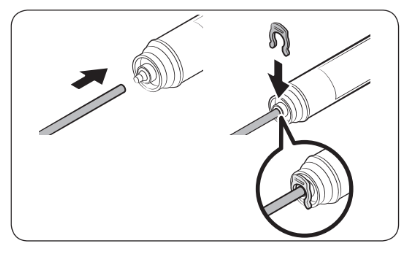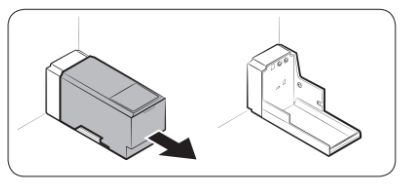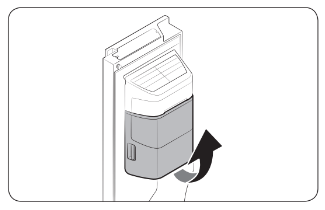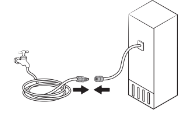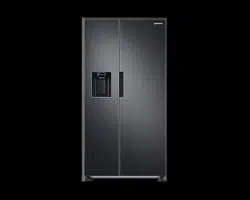Documents: Go to download!
- User Manual - (English)
- Repair Guide - (English)
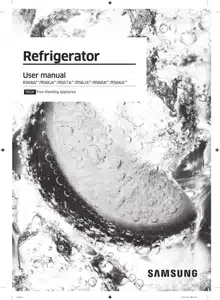
- Installation
- Operations
- Maintenance
- Troubleshooting
Table of contents
USER MANUAL
Installation
Follow these instructions carefully to ensure a proper installation of this refrigerator and to prevent accidents before using it.
Refrigerator at a glance
The actual appearance of your refrigerator may differ, depending on the model and the country.
Normal models

Dispenser-featured models

Step-by-step installation
STEP 1 Select a site
Site requirements:
- Solid, level surface without carpeting or flooring that may obstruct ventilation
- Away from direct sunlight
- Adequate room for opening and closing the door
- Away from a heat source
- Room for maintenance and servicing
- Temperature range: between 5 °C and 43 °C
Clearance
See the pictures and table below for space requirements for installation.

STEP 2 Spacing (applicable models only)
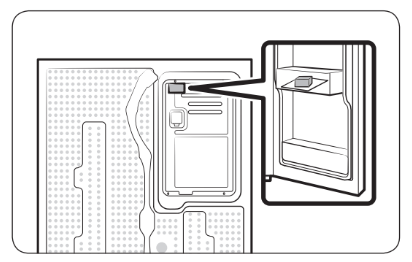 |
|
STEP 3 Flooring
 |
|
STEP 4 Adjust the levelling feet
The refrigerator can be levelled using the front legs that have a special screw (leveller) for levelling purposes. Use a flat-head screwdriver for levelling.
 | To adjust the height of the freezer side: Insert a flat-head screwdriver into the leveller of the freezer-side front leg. Turn the leveller clockwise to raise, or turn it counter clockwise to lower.
|
 | To adjust the height of the fridge side: Insert a flat-head screwdriver into the leveller of the fridge-side front leg. Turn the leveller clockwise to raise, or turn it counter clockwise to lower.
|
STEP 5 Adjust the door height as well as the door gap
To adjust the height of a door
The height of a door can be adjusted using the clamp nut and the height nut on the front bottom of each door.
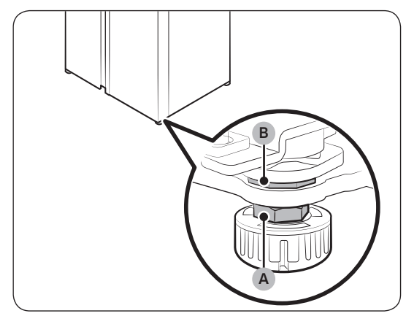 | 1. Open the door to adjust, and locate the two nuts (A) and (B) on the front bottom of the door. |
 | 2. With a 19 mm spanner (provided), turn the clamp nut (A) clockwise to loosen. Then, open the door, and do the following inside the door.
|
 | 3. When complete, tighten the clamp nut (A) by turning it counter clockwise. |
STEP 6 Connect the water dispenser line (applicable models only)

Installation (external dispenser line)
 |
|
STEP 7 Connect to a water source (applicable models only)
To connect the water filtering hose to the water line
|
| |
 | NOTE: If you have to relocate the refrigerator after connecting the water line, make sure the joined section of the water line must is straight |
To repair the water line
CAUTION
The water line must be repaired by a qualified professional. If you encounter a water leak, contact a local Samsung service centre or the installer of the water line.
Reverse osmosis water filtration system
The water pressure of the water supply system to a reverse osmosis water filtration system must be between 241 kPa and 827 kPa.
The water pressure of the reverse osmosis water filtration system to the refrigerator’s cold water line must be at least 276 kPa. If the water pressure is below the specified:
- Check if the sediment filter in the reverse osmosis system is blocked. Replace the filter if necessary.
- Refill the water tank in the reverse osmosis system with water.
- If your refrigerator has a water filter, it may further reduce the water pressure when used in conjunction with a reverse osmosis system. Remove the water filter.
For more information or servicing, contact a licensed plumbing professional.
NOTE
WATER FILTER MUST BE INSTALLED.
- Make sure to install a water filter.
- Failing to install a water filter may allow fine foreign materials (sand, lime) in the water to continuously enter the water supply line and possible cause defects in the water supply system.
Ordering a new filter
To purchase a new water filter (part type: HAFEX/EXP), contact a local Samsung service centre.
To mount the water filter into place
 |
|
 | CAUTION: Do not mount the water filter on any part of the refrigerator. This may damage the refrigerator. |
Water filter replacement (applicable models only)
|
|
STEP 8 Initial settings
By completing the following steps, the refrigerator should be fully functioning.
- Plug the power cord into the wall socket to turn the refrigerator on.
- Open the door, and check if the interior light lights up.
- Set the temperature to the coldest, and wait for about an hour. Then, the freezer will be slightly chilled, and the motor will run smoothly.
- Wait until the refrigerator reaches the set temperature. Now the refrigerator is ready for use.
STEP 9 Final check
When installation is complete, confirm that:
- The refrigerator is plugged into an electrical outlet and grounded properly.
- The refrigerator is installed on a flat, level surface with a reasonable clearance from the wall or the cabinet.
- The refrigerator is level and is sitting firmly on the floor.
- The door opens and closes freely, and the interior light turns on automatically when you open the door.
Door removal for entrance
If the refrigerator cannot pass through the entrance due to its size, follow these instructions:
Tools required (not provided)
These tools are used for removing the doors.

Disconnect the water line

1. From the bottom rear side of the refrigerator, pull out the water line to the front.
NOTE
The refrigerator’s water line is a water circulation line that connects between the water pipe from the water source and the hoses from the water filtering system of the refrigerator.

2. To disconnect the hoses, press and hold the collet (A) and detach the water hose (B).
CAUTION
Do not apply excessive force to the coupler. It may break.
Detach the doors
 |
|
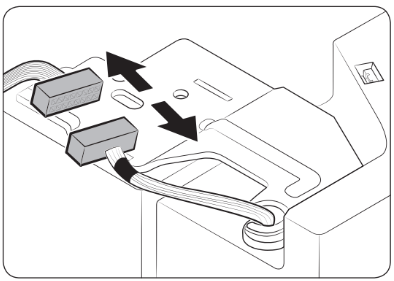 | 3. Disconnect the electrical harness. |
 | 4. Gently lift the clamp. NOTE To prevent damage to the clamp or injuries, do not lift the clamp forcefully. |
 | 5. Pull the clamp to remove. |
 | 6. Open the door by 90 degrees. While holding the door, remove the hinge. |
Reconnect the water hoses
Once the refrigerator has passed through the entrance, reconnect the water hoses.
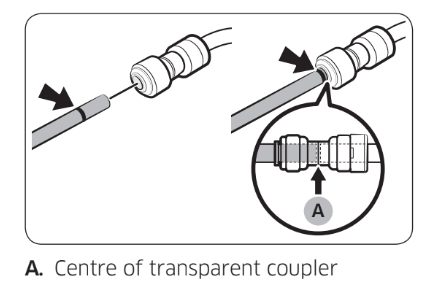
CAUTION
- Make sure the water hoses are connected with matching colours.
- To prevent water leaks, each water hose must be inserted fully to the centre of the transparent coupler.
- After reconnecting the water hoses, push them under the cabinet and arrange them on the hook.
Reattach the doors
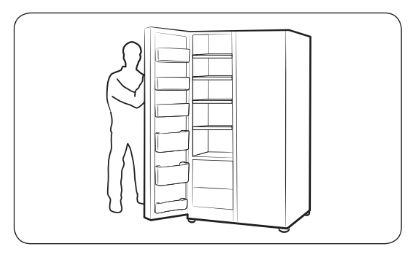 | 1. Hold the freezer door and hook to the hinge at the bottom of the refrigerator. | |
 | 2. Put the hinge into its position, and then insert it into the hole on the door. | |
 | 3. Insert the clamp in the arrow direction. | |
 | 4. Press the clamp as shown. | |
 | 5. Connect the electrical harness. | |
 | 6. Insert the hinge covers with the front sides first, and then tighten the screws. Use a Phillips screwdriver for this step. |
Operations
Feature panel

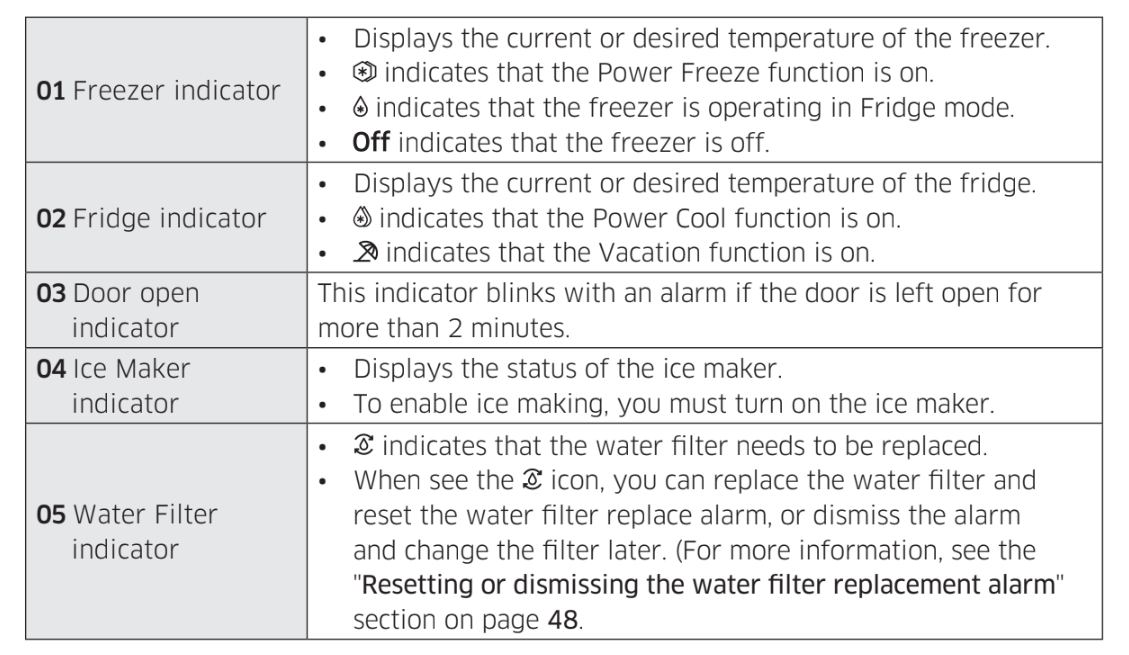

Setting the desired temperature or function
1. Tap any button (< , O , or >) to wake up the display.
- This step may not apply to some models.
2. Tap O to select the fridge or freezer.
- The selected compartment’s indicator blinks.
- The degrees Celsius symbol (°C) does not blink.
3. Tap < or > to select the desired temperature or function.
- Refer to the table for available selection for each compartment.


4. Wait for 5 seconds to confirm your selection.
- The selected compartment’s indicator stops blinking.
Turning on or off the ice maker
You can turn on or off the auto ice maker in the freezer.
1. Tap any button ( < , O , or >) to wake up the display.
- This step may not apply to some models.
2. Tap O until the Ice Maker indicator blinks.
3. Tap < or > to turn on or off the ice maker.
- Tap < to turn it on.
- Tap > to turn it off.
4. Wait for 5 seconds or tap O to confirm your selection.
- The Ice Maker indicator stops blinking.
Resetting or dismissing the water filter replacement alarm
The water filter replacement icon (  ) blinks to alert the user that it is time to replace the water filter. You can replace the water filter immediately and reset the water filter replacement alarm, or dismiss the alarm if you want to change the water filter later.
) blinks to alert the user that it is time to replace the water filter. You can replace the water filter immediately and reset the water filter replacement alarm, or dismiss the alarm if you want to change the water filter later.
1. Tap any buttons ( < , O , or >) to wake up the display.
- This step may not apply to some models.
2. Tap O until the Water Filter indicator blinks.
3. Tap < or > to select Reset or Later.
- If you have changed the water filter, tap to reset the water filter replacement alarm.
- If you want to change the water filter later and dismiss the alarm, tap .
4. Wait for 5 seconds or tap O to confirm your selection.
- The Water Filter indicator stops blinking.
Dispenser panel (applicable models only)

01 Water / Lock (3 sec)
| Water | To dispense chilled water, press Water. The corresponding indicator turns on. |
| Lock (Dispenser panel / Dispenser lever) | To prevent use of the dispenser panel buttons and the dispenser lever, press and hold Water for more than 3 seconds. If you press and hold the button again for more than 3 seconds, the dispenser lock will be deactivated. NOTE The Lock on the dispenser panel does not affect the controls on the main panel. To lock the main panel, use the Control Lock function on the main panel. |
02 Cubed Ice
| Cubed Ice | Press Cubed Ice to dispense cubed ice. The corresponding indicator turns on. |
03 Crushed Ice
| Crushed Ice | Press Crushed Ice to dispense crushed ice. The corresponding indicator turns on. |
Special features
The refrigerator features user-oriented devices that you can use to benefit from.
Water/Ice dispenser (applicable models only)
Using the dispenser, you can dispense water with or without ice.
The water dispenser offers 3 options: chilled water, cubed ice, and crushed ice. To dispense chilled water, press Water on the dispenser panel. Put a water glass under the dispenser, and then push the dispenser lever.
To dispense water with ice
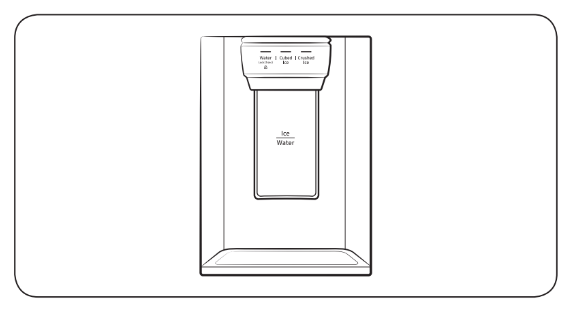
- With the Ice Maker enabled, press Cubed Ice or Crushed Ice to select the ice type.
- Put a water glass under the dispenser, and then push the dispenser lever with the glass. Ice will be dispensed from the dispenser.
- Press Water to select water.
- Push the dispenser lever with the glass. Water will be dispensed from the dispenser.
Ice maker (applicable models only)
The refrigerator has a built-in ice maker that automatically dispenses ice so that you can enjoy filtered water with cubed or crushed ice.
Ice making
After you have installed your refrigerator and plugged it in, follow these instructions to ensure proper ice making and to keep the ice bucket full of ice:
- Let the refrigerator operate for at least 24 hours to ensure optimal performance.
- Dispense the first 4 to 6 ice cubes into a glass.
- Wait another 8 hours and dispense another 4 to 6 ice cubes.
- Then, wait another 16 hours and dispense the first glass-full of ice.
To fill the water tank (applicable models only)
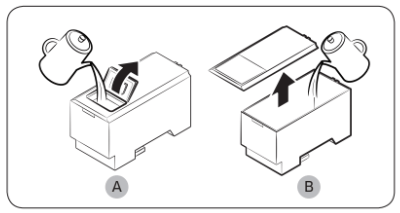  | For first-time use, clean the inner side of the water tank and dry well. 1. Hold both handgrips on the front of the tank, and slide out as shown. 2. Open the front lid (A) of the cover or the entire cover (B) and fill the tank with a max of 5 litres water. CAUTION: Do not exceed the max line. Water overflows. Fill with potable water only. 3. Reinsert the water tank and fit into the dispenser mechanism. Make sure the front side (with the front lid) of the tank faces to the front. |
For first-time use
- Push the dispenser lever for 10 seconds to emit air from the hoses of the water supply system.
- Discard the first six glasses of water to remove impurities in the water supply system.
Ice making (applicable models only)
The refrigerator has a built-in ice maker that automatically dispenses ice so that you can enjoy filtered water with cubed or crushed ice to your preference.
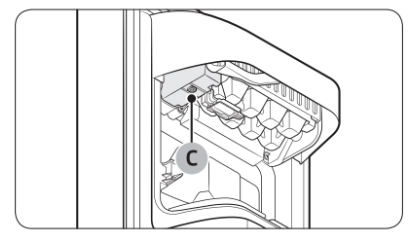 | If ice does not dispense, first check the ice maker if it makes ice properly. To check the ice maker
|
To secure more storage space (applicable models only)
 | If you do not use the ice maker and need more storage space, remove the icemaker bucket (A). Then, insert the Freezer guide (Optional) (B) into the icemaker bucket’s place. | |
 | To secure more space, remove the upper drawer (C), lower drawer (D), and lower drawer cover (E). Then, insert the provided bottom shelf (F). | |
 | For more space, remove the water tank and use the space to store more items. | |
Icemaker bucket
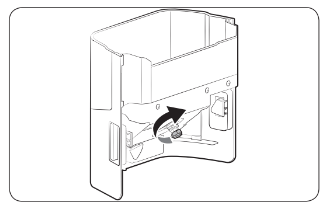 | If you do not dispense ice for an extended period, ice may form clumps inside the bucket. If this happens, remove and empty the icemaker bucket.
|
 | CAUTION
|
Water pressure
If you want to check how much water flows into the ice tray, follow these steps.

- Remove the ice bucket.
- Press the button (A) on the bottom of the ice maker. Normally, the ice tray fills with water in a few minutes.
- If the water level is lower than expected, check the water pressure of the water supply line from the water source. This is not a system failure.
Maintenance
Handle and care
Shelves (fridge/freezer) / Wine rack (applicable models only)

1. Pull out the shelf (or wine rack) a little. Then, while lifting the rear side, pull out.

2. Twist the shelf (or wine rack) diagonally to remove.
Door bins

To remove a door bin, hold the front sides of the bin and gently lift up to remove.
Drawers

Gently lift up the front of the drawer and slide out.
Vegetable / Dried food and meat storage drawer
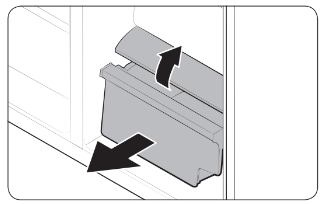
To remove the vegetable drawer from the fridge or the dry drawer from the freezer:
1. First, remove surrounding multipurpose drawers if necessary.

2. If your refrigerator has a cover (A) for the vegetable/dry drawer, remove it in the following method.
a. Pull the drawer halfway out.
b. Pull the cover while pressing the rear sides (as marked in the figure).
3. Gently pull out the vegetable/dry drawer.
Icemaker bucket
To remove the ice maker bucket, see the Icemaker bucket section on page 55.
Cleaning
Interior and exterior
Regularly use a dry cloth to remove all foreign substances such as dust or water from the power plug terminals and contact points.
- Unplug the power cord.
- Use a moistened, soft, lint-free cloth or paper towel to clean the refrigerator’s interior and exterior.
- When done, use a dry cloth or paper towel to dry well.
- Plug in the power cord.
Ice / Water dispenser (applicable models only)
NOTE
For hygienic purposes, frequently clean the dispenser area.
CAUTION
When crushed ice is selected, some residual ice chips may collect in the ice chute. To prevent this, remove the residual ice from the chute using a soft, clean cloth.
Rubber seals
If the rubber seals of a door become dirty, the door may not close properly and reducing refrigerator performance and efficiency. Use a mild detergent and damp cloth to clean the rubber seals. Then, dry well with a cloth.
Rear panel

To keep cords and exposed parts of the rear panel free of dirt, vacuum the panel once or twice a year.
Replacement
Lamps
The lamps are not user-serviceable. To replace the lamps of the refrigerator, contact a local Samsung service centre.
Troubleshooting
Before calling for service, review the checkpoints below. Any service calls regarding normal situations (No Defect Cases) will be charged to users.
Temperature
| Symptom | Possible causes | Solution |
| Fridge/freezer does not operate. Fridge/freezer temperature is warm. |
|
|
|
| |
|
| |
|
| |
|
| |
| Fridge/freezer is over-cooling. |
|
|
| Interior wall is hot. |
|
|
Odour
| Symptom | Possible causes | Solution |
| Refrigerator has odours. |
|
|
|
|
Frost
| Symptom | Possible causes | Solution |
| Frost around the vents. |
|
|
| Frost on interior walls. |
|
|
Condensation
| Symptom | Possible causes | Solution |
| Condensation forms on the interior walls. |
|
|
|
|
Water/ice (dispenser models only)
| Symptom | Possible causes | Solution |
| Water flow is weaker than normal. |
|
|
| Ice maker makes a buzzing sound. |
|
|
| Ice maker does not make ice. |
|
|
|
| |
|
| |
|
|
| Ice does not dispense. |
|
|
|
| |
|
| |
| Water does not dispense. |
|
|
|
| |
|
|
Do you hear abnormal sounds from the refrigerator?
Before calling for service, review the checkpoints below. Any service calls related to normal sounds will be charged to the user.
These sounds are normal.
- When starting or ending an operation, the refrigerator may make sounds similar to a car engine igniting. As the operation stabilizes, the sounds will decrease.

- While the fan is operating, these sounds may occur. When the refrigerator reaches the set temperature, no fan sound will occur.

- During a defrost cycle, water may drip on the defrost heater, causing sizzling sounds.

- As the refrigerator cools or freezes, refrigerant gas moves through sealed pipes, causing bubbling sounds.

- As the refrigerator temperature increases or decreases, plastic parts contract and expand, creating knocking noises. These noises occur during the defrosting cycle or when electronic parts are working.

- For ice maker models: When the water valve opens to fill the ice maker, buzzing sounds may occur.
- Due to pressure equalizing when opening and closing the refrigerator door, whooshing sounds may occur.
See other models: RF50A5202B1/EU RF50A5202S9/EU EO-IC500BBEGWW SM-R170NZWABTU SM-R170NZYABTU



